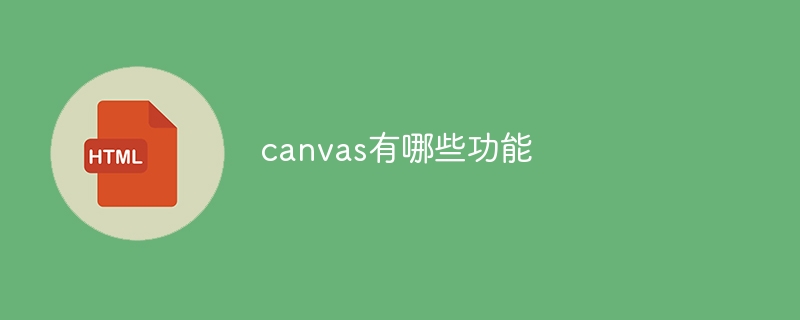
Canvas functions include drawing basic shapes, drawing images, drawing text, drawing paths, drawing gradients and shadows, animation effects, graphic transformations and image processing. Detailed introduction: 1. Canvas provides methods for drawing basic shapes, such as rectangles and circles. By setting different properties, such as color and line width, you can create various shapes; 2. Canvas can draw images, including For bitmap and vector images, you can use the "drawImage()" method to draw the image onto the canvas, and the image can be scaled, cropped, etc.

# Operating system for this tutorial: Windows 10 system, Dell G3 computer.
Canvas is a tag in HTML5 used to draw graphics, animations and other visual effects on web pages. It provides a blank canvas on which graphics can be drawn via JavaScript. Canvas has many features that can be used to create a wide variety of graphics and animation effects.
The following are some of the main functions of Canvas:
1. Draw basic shapes: Canvas provides methods for drawing basic shapes, such as rectangles, circles, straight lines, arcs, etc. A variety of different shapes can be created by setting different properties such as color, line width, fill, etc.
2. Draw images: Canvas can draw images, including bitmaps and vectors. You can use the drawImage() method to draw an image onto the canvas, and perform operations such as scaling, cropping, and rotating the image.
3. Draw text: Canvas can draw text and set attributes such as font, font size, color, alignment, etc. Text can be drawn to the canvas using the fillText() or strokeText() methods.
4. Draw paths: Canvas can create complex graphics by drawing paths. You can use the moveTo() method to move the drawing cursor to a specified position, and then use methods such as lineTo(), arcTo(), quadraticCurveTo(), etc. to draw the path. You can control the style of the path by setting different properties, such as line width, line type, fill, etc.
5. Draw gradients and shadows: Canvas supports drawing linear gradients, radial gradients and shadow effects. You can create a gradient object using the createLinearGradient() or createRadialGradient() method, and set the gradient's color using the addColorStop() method. Shadow effects can be created using the shadowOffsetX, shadowOffsetY, shadowBlur, and shadowColor properties.
6. Animation effects: Canvas can achieve animation effects through JavaScript. You can use the requestAnimationFrame() method to loop through the canvas to create a continuous animation effect. You can use the clearRect() method to clear the contents of the canvas before redrawing a new frame.
7. Graphics transformation: Canvas supports transformation operations such as translation, rotation, scaling and tilting of graphics. You can use the translate(), rotate(), scale() and transform() methods to perform graphics transformations. The state of the canvas can be saved and restored using the save() and restore() methods.
8. Image processing: Canvas provides some image processing methods, such as pixel operations, filter effects, color adjustment, etc. You can use the getImageData() method to obtain the pixel data of a specified area on the canvas and modify the pixels. You can use the filter attribute to apply filter effects such as blur, brightness, contrast, etc.
To sum up, Canvas is a powerful graphics drawing tool that can be used to create a variety of graphics and animation effects. It can draw basic shapes, images, and text, it can draw complex paths, it can apply gradient and shadow effects, it can animate effects, and it can perform image processing. By rationally using these functions, you can create rich and diverse visual effects, adding vividness and appeal to web pages.
The above is the detailed content of What functions does canvas have?. For more information, please follow other related articles on the PHP Chinese website!




